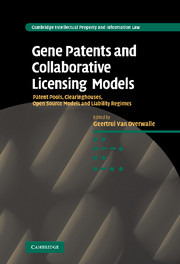 Gene Patents and Collaborative Licensing Models
Gene Patents and Collaborative Licensing Models Book contents
- Frontmatter
- Contents
- List of contributors
- Preface
- Foreword: Jean-Jacques Cassiman
- List of abbreviations
- Part I Patent pools
- Part II Clearinghouses
- Part III Open source models
- 12 Open source genetics. Conceptual framework
- 13 Case 8. CAMBIA's Biological Open Source Initiative (BiOS)
- 14 Case 9. Diversity Arrays Technology Pty Ltd. (DArT) Applying the open source philosophy in agriculture
- 15 Critical commentary on ‘open source’ in the life sciences
- 16 Several kinds of ‘should’. The ethics of open source in life sciences innovation
- Part IV Liability regimes
- Part V Different perspectives
- Part VI Summary and concluding analysis
- Index
- Titles in the series
15 - Critical commentary on ‘open source’ in the life sciences
from Part III - Open source models
Published online by Cambridge University Press: 14 January 2010
- Frontmatter
- Contents
- List of contributors
- Preface
- Foreword: Jean-Jacques Cassiman
- List of abbreviations
- Part I Patent pools
- Part II Clearinghouses
- Part III Open source models
- 12 Open source genetics. Conceptual framework
- 13 Case 8. CAMBIA's Biological Open Source Initiative (BiOS)
- 14 Case 9. Diversity Arrays Technology Pty Ltd. (DArT) Applying the open source philosophy in agriculture
- 15 Critical commentary on ‘open source’ in the life sciences
- 16 Several kinds of ‘should’. The ethics of open source in life sciences innovation
- Part IV Liability regimes
- Part V Different perspectives
- Part VI Summary and concluding analysis
- Index
- Titles in the series
Summary
Introduction
The conceptual paper and case studies in this section evaluate possible extensions of the “open source”-style private ordering that has emerged in software to the life sciences. In evaluating such extensions, it is important initially to note the historical context in which open source emerged in software and the many flavors in which open source software currently comes. From this clarification of first principles, we can then imagine what open source in the life sciences might look like.
Background and clarification of principles
The concept of open source in software has its origins in the quasi-Mertonian ethic that prevailed among academic laboratories in the 1960s and 1970s. At the time, packaged software was relatively unusual, and labs regularly exchanged software and underlying source code for purposes of modification and improvement. The emergence of packaged software offered without underlying source code began to erode this Mertonian ethic. As Janet Hope points out, one response to such erosion was Richard Stallman's GPL license, which utilizes copyright licensing to mandate an expanding “commons” of source code. The GPL license not only sets up a situation where the source code commons can not be made proprietary, but by so doing it may create incentives to contribute in the first instance. A large percentage of open source software licenses continue to employ some version of Stallman's “copyleft” approach.
- Type
- Chapter
- Information
- Gene Patents and Collaborative Licensing ModelsPatent Pools, Clearinghouses, Open Source Models and Liability Regimes, pp. 213 - 218Publisher: Cambridge University PressPrint publication year: 2009
- 2
- Cited by


